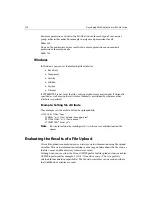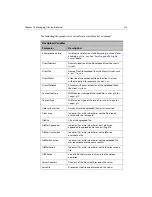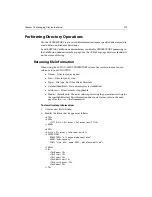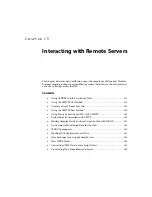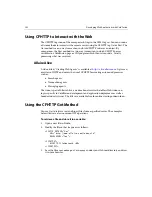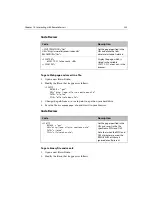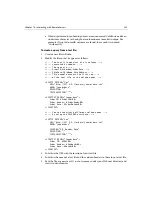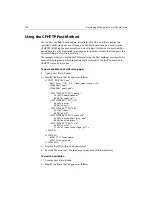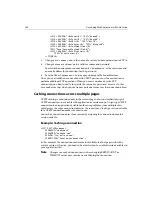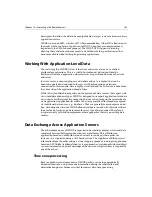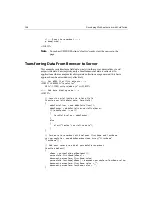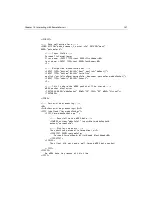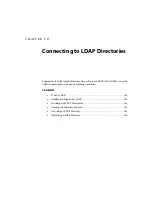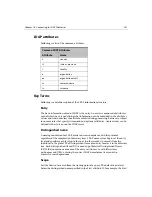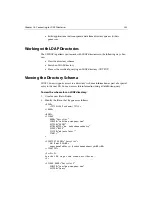
238
Developing Web Applications with ColdFusion
This example runs a CGI program,
search.exe
, that searches the site and returns the
hits on the value specified in VALUE.
Using Secure Sockets Layer (SSL) with CFHTTP
When using Secure Sockets Layer (SSL) to transmit secured transactions via CFHTTP,
you need to be aware of limitations on its use caused by a bug in one of the
components of Microsoft’s InetSDK. The problem occurs on Windows NT and should
not affect Windows 95/98 machines.
CFHTTP uses the InetSDK to conduct all HTTP and HTTPS transactions and relies on
the WinInet DLL and Schannel DLL for its SSL implementation. The WinInet bug
constrains storage of SSL certificate information to the user level. This means that
WinInet does not interrogate the registry for certificate information if the client that
loads the DLL is a service. As a result, a CFHTTP request to an
https:// url,
will fail if
ColdFusion is running as a service.
While we strongly recommend that the ColdFusion Server be run as a service, a
workaround for this SSL/WinInet problem is available. The workaround is to run
ColdFusion as a desktop application when SSL is needed. In this way, WinInet will
write to and read from the registry appropriately when negotiating certificate
information.
To run ColdFusion as a desktop application:
1.
From the Windows NT Start menu in, select Run.
2.
Type the following (assuming that your installation of CF is in the default
location):
c:\cfusion\bin\cfserver –DESKTOP
3.
The ColdFusion icon should appear in the Windows Task Bar.
When running the ColdFusion server as a desktop application rather than as a service,
keep the following in mind:
•
Access the server from the Window Control Panel Services dialog.
•
The server must be cycled manually by loading and unloading the ColdFusion
Application Server process.
•
The server cannot be stopped or started from the ColdFusion Administrator.
•
If the server goes down, the Executive will restart it as a service, not as a desktop
application, and all subsequent SSL transactions will fail.
To determine whether the encryption key size conforms to export laws:
1.
Right mouse click on Schannel.dll.
2.
Select Properties.
3.
Click the Version tab.
If the Description field reads "PCT / SSL Security Provider (Export Version)", a 40-
bit key was used.
Summary of Contents for COLDFUSION 4.5-DEVELOPING WEB
Page 1: ...Allaire Corporation Developing Web Applications with ColdFusion ColdFusion 4 5...
Page 14: ...xiv Developing Web Applications with ColdFusion...
Page 26: ...xxvi Developing Web Applications with ColdFusion...
Page 34: ...8 Developing Web Applications with ColdFusion...
Page 70: ...44 Developing Web Applications with ColdFusion...
Page 84: ...58 Developing Web Applications with ColdFusion...
Page 114: ...88 Developing Web Applications with ColdFusion...
Page 148: ...122 Developing Web Applications with ColdFusion...
Page 174: ...148 Developing Web Applications with ColdFusion...
Page 208: ...182 Developing Web Applications with ColdFusion...
Page 244: ...218 Developing Web Applications with ColdFusion...
Page 274: ...248 Developing Web Applications with ColdFusion...
Page 288: ...262 Developing Web Applications with ColdFusion...
Page 300: ...274 Developing Web Applications with ColdFusion...
Page 350: ...324 Developing Web Applications with ColdFusion...
Page 362: ...336 Developing Web Applications with ColdFusion...

